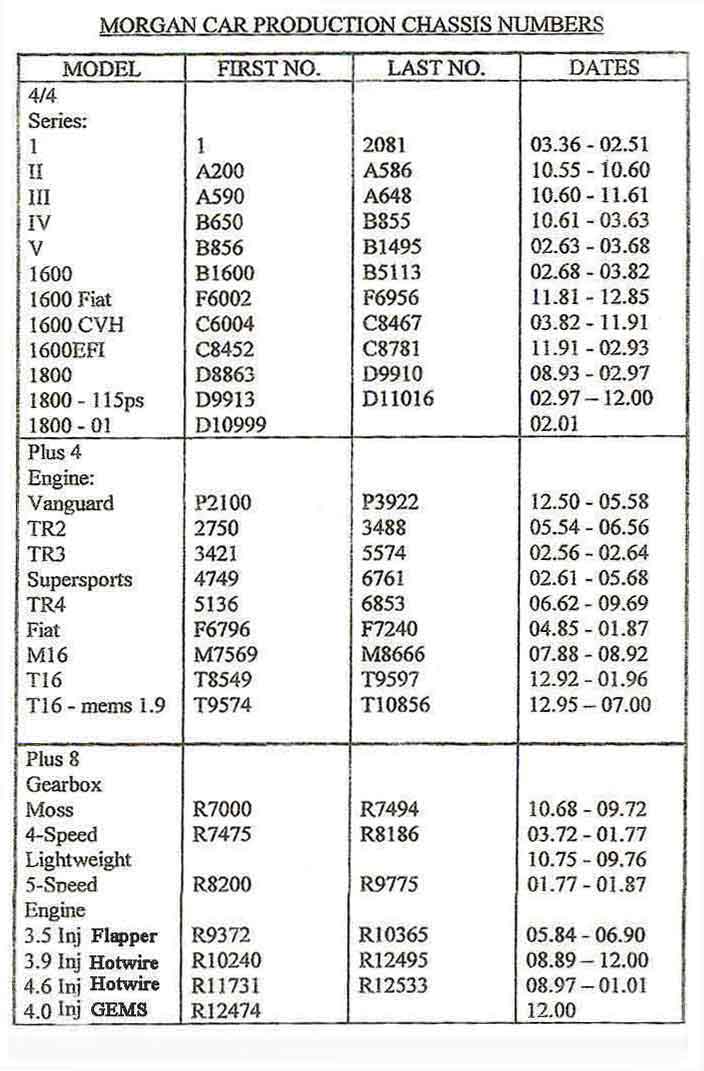MORGAN CHASSIS NUMBERS
by Lorne Goldman
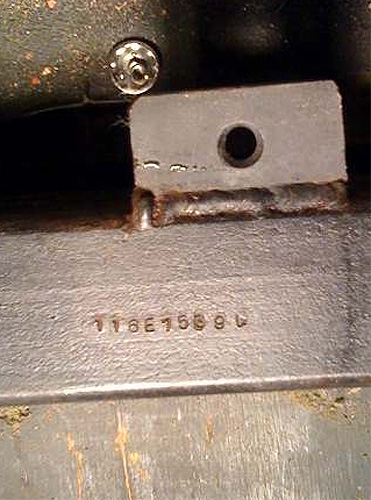
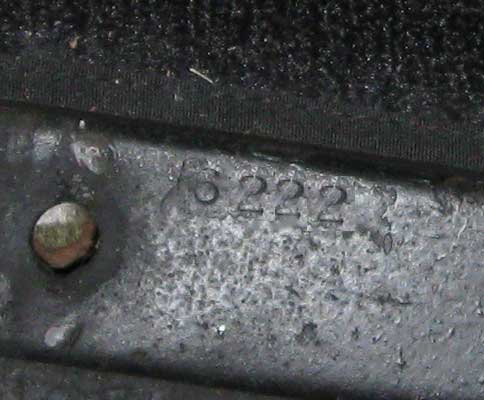 Yes, they changed their
position on
the cars over the years and were not always easy to find. In the
fullness
of time (in the 1980s) the company was required to conform to
government
regulations on these numbers..forcing them to adopt a minimum number of
alpha numeric numbers in an easily accessible place, most often on the
bulkhead or the bulkhead toolbox or the hidden part of the hinge of the
bonnet (the nickname of the bonnet maker on one side and the VIN on the
other). However, the earlier secret places remained
in use for many years even into the more modern era. Within the Morgan
communiity, the only important numbers are the few Morgan ones at the end
of the long modern VIN.
Yes, they changed their
position on
the cars over the years and were not always easy to find. In the
fullness
of time (in the 1980s) the company was required to conform to
government
regulations on these numbers..forcing them to adopt a minimum number of
alpha numeric numbers in an easily accessible place, most often on the
bulkhead or the bulkhead toolbox or the hidden part of the hinge of the
bonnet (the nickname of the bonnet maker on one side and the VIN on the
other). However, the earlier secret places remained
in use for many years even into the more modern era. Within the Morgan
communiity, the only important numbers are the few Morgan ones at the end
of the long modern VIN.
With older cars, the numbers
were scratched or stamped, most often, on the crossmember behind the seats.
Of course, time and paint can obscure these but trust me, they are there.
The other possibility of a
site is on the inside of the bonnet hinge. If you open your bonnet fully
you will often find the number AND a name..which will be the nickname of
the skilled fellow who made your Morgan's bonnet. However, since PM's passing, the management has
abandonned its former reliance on inhouse human skills and embraced copies of the
original components, now outsourced and made by the use of modern technology.
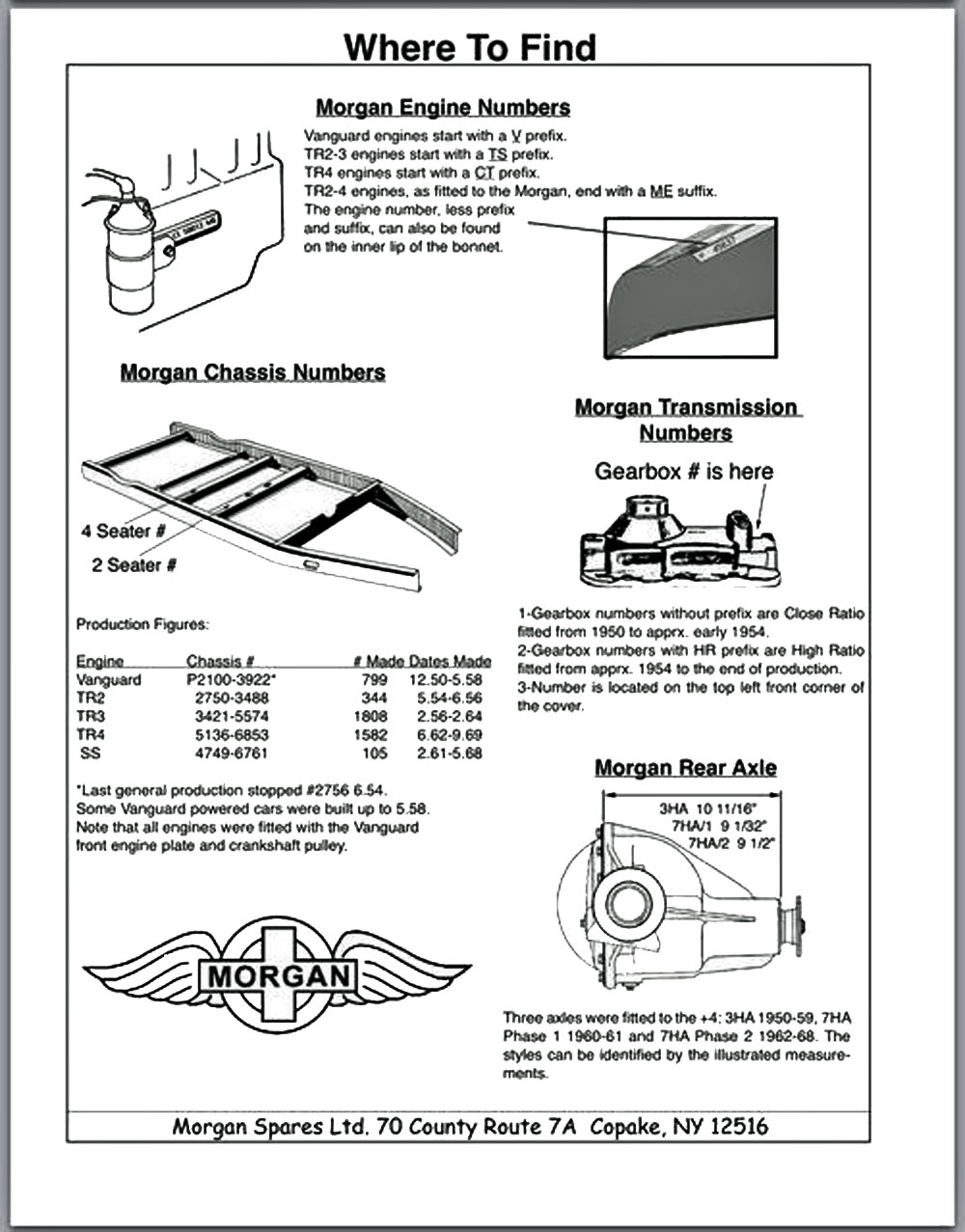
PERSONAL MARKS FROM THE WORKS
by Lorne Goldman
This placing of personal
marks and nicknames on the cars was a charming custom from the old days.
Morgan workers would place their nickname or sign on hidden
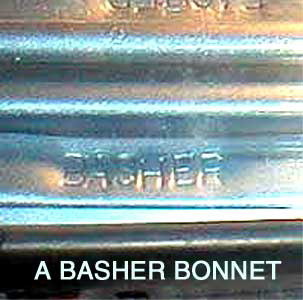 places on the
car..expressing the pride they had in what they had made. The most extreme
example was the Work's rebuild of this author's car,
places on the
car..expressing the pride they had in what they had made. The most extreme
example was the Work's rebuild of this author's car, 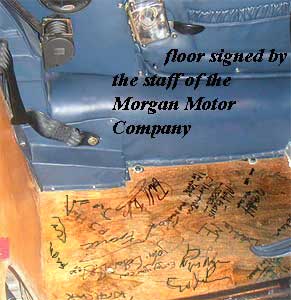 where the entire staff
of the Morgan Motor Company signed the floors underneath the seats.
where the entire staff
of the Morgan Motor Company signed the floors underneath the seats.
Here are some numbers from
the Golden Age of Morgan to get you started! All Plus 8 numbers start
with R. The confusion only became worse in the modern eraa. Here are some VIN basics. Then look
at the bottom for a note specific to Morgans.
How to Decipher a VIN
by Mark Kennan
The vehicle identification number (VIN) is a 17-character
code assigned to every new vehicle produced. The VIN contains information
about the car's manufacturer, location of construction, year and model
information. The VIN is used to track the history of the vehicle so people
can learn about a vehicle before purchasing it. In addition, it can be
used to confirm stolen vehicles. In order to decipher the VIN, you need
to know which digits represent which aspects of the car.
1. Locate the first character of the VIN. This number
is used to denote where the car was built. The number "1" or "4" means
the car was built in the United States, "2" means the car was built in
Canada, "3" means the car was built in Mexico, "J" means the car was built
in Japan, "K" means the car was built in Korea, "S" means the car was built
in England, "W" means the car was built in Germany and "Z" means the car
was built in Italy.
2. Determine the car's manufacturer by looking at the
second character of the VIN. For example, an "H" means the car was made
by Honda or a "1" means the car was made by Chevrolet. However, there are
some manufacturers that use the same character. For example, both Audi
and Jaguar use "A" and both BMW and Dodge use "B." The third number will
denote the division of the company that built the car.
3. Use the fourth through the eighth characters in the
VIN number to find out information about the car's features. Information
denoted by these numbers includes the engine and body type of the car.
These numbers are determined by the car manufacturer and are not universally
standardized.
4. Skip the ninth digit. This digit does not tell you
anything about the car. Instead, it is a check digit based on the other
digits in the VIN.
5. Determine the model year for your car based on the
10th digit. The pattern includes 30 digits starting with A through Z (with
I, O, Q, U and Z not used) then the numbers 1 through 9. The pattern started
in 1980 with "A". You can also use the model year chart (see resources)
to find the year of manufacture. The 11th digit gives information about
which plant produced the car and varies among manufacturers.
6. Find the serial number based on the last six numbers.
Depending on the manufacturer, this number may be reset to "000001" each
year or each model or may just continue to increase.
|
WATCHPOINT At
one point in the 1990s someone made a VIN plaque with the extra numbers
to comply with North American Law.. They would merely stamp the true
Morgan VINs we go by at the end of the plaque. However, an extra number
was included in the stamped part of all the plaques. In many countries,
this makes the re-registration of Morgans from another country very
difficult. The local government offices refuse them and the difficulty
in having the plaque replaced with the required documentation from the
MMC is legendary. I strongly advise those with this problem to start your work for a new replacement plaque now.
|

 Yes, they changed their
position on
the cars over the years and were not always easy to find. In the
fullness
of time (in the 1980s) the company was required to conform to
government
regulations on these numbers..forcing them to adopt a minimum number of
alpha numeric numbers in an easily accessible place, most often on the
bulkhead or the bulkhead toolbox or the hidden part of the hinge of the
bonnet (the nickname of the bonnet maker on one side and the VIN on the
other). However, the earlier secret places remained
in use for many years even into the more modern era. Within the Morgan
communiity, the only important numbers are the few Morgan ones at the end
of the long modern VIN.
Yes, they changed their
position on
the cars over the years and were not always easy to find. In the
fullness
of time (in the 1980s) the company was required to conform to
government
regulations on these numbers..forcing them to adopt a minimum number of
alpha numeric numbers in an easily accessible place, most often on the
bulkhead or the bulkhead toolbox or the hidden part of the hinge of the
bonnet (the nickname of the bonnet maker on one side and the VIN on the
other). However, the earlier secret places remained
in use for many years even into the more modern era. Within the Morgan
communiity, the only important numbers are the few Morgan ones at the end
of the long modern VIN.

 places on the
car..expressing the pride they had in what they had made. The most extreme
example was the Work's rebuild of this author's car,
places on the
car..expressing the pride they had in what they had made. The most extreme
example was the Work's rebuild of this author's car,  where the entire staff
of the Morgan Motor Company signed the floors underneath the seats.
where the entire staff
of the Morgan Motor Company signed the floors underneath the seats.